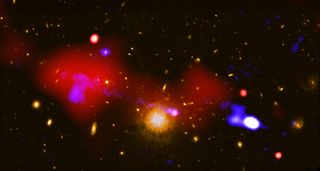Although black holes are notorious for devouring any matter that gets too close, these cosmic behemoths may have a nurturing side, too.
Using data from NASA's Chandra X-ray Observatory and other telescopes, researchers discovered a black hole that has sparked star formation in multiple galaxies across tremendous distances.
"This is the first time we've seen a single black hole boost star birth in more than one galaxy at a time," Roberto Gilli, lead author of the study and a researcher from the National Institute of Astrophysics (INAF) in Bologna, Italy, said in a statement from the Chandra X-ray Observatory. "It's amazing to think one galaxy's black hole can have a say in what happens in other galaxies millions of trillions of miles away."
Related: Images: Black Holes of the Universe

The black hole is located at the center of a galaxy about 9.9 billion light-years from Earth. Scientists believe it has spurred star formation in at least four neighboring galaxies that are more than 1 million light-years away — the longest distance over which a black hole has ever triggered the formation of new stars, according to the statement.
Stars generally form where gas and dust build up, creating what is known as a stellar nursery. Active supermassive black holes generate powerful outflows of material, or jets, from which new stars may form.
"The story of King Midas talks of his magic touch that can turn metal into gold," Marco Mignoli, co-author of the study and researcher from the INAF, said in the statement. "Here, we have a case of a black hole that helped turn gas into stars, and its reach is intergalactic."
Black holes feed off material from a disk of surrounding matter. This process produces powerful X-ray emissions, which researchers observed using Chandra. This data was combined with observations from the NSF's Karl Jansky Very Large Array (VLA), which detected radio-wave emissions produced by the jet of particles streaming from the black hole.
The Chandra data also revealed that one end of the jet is surrounded by a bubble of hot gas, which is created by the jet's particles interacting with the surrounding matter. Over time, the bubble expanded toward the neighboring galaxies and potentially created a shock wave that caused nearby gas to compress and form new stars, according to the statement.
"Black holes have a well-earned reputation for being powerful and deadly, but not always," Alessandro Peca, co-author of the study and Ph.D. student at the University of Miami, said in the statement. "This is a prime example that they sometimes defy that stereotype and can be nurturing instead."
Their findings were published Sept. 18 in the journal Astronomy and Astrophysics.
Follow Samantha Mathewson @Sam_Ashley13. Follow us on Twitter @Spacedotcom and on Facebook.

Bagikan Berita Ini














0 Response to "A Black Hole Is Boosting Star Birth in Multiple Galaxies from Trillions of Miles Away - Space.com"
Post a Comment